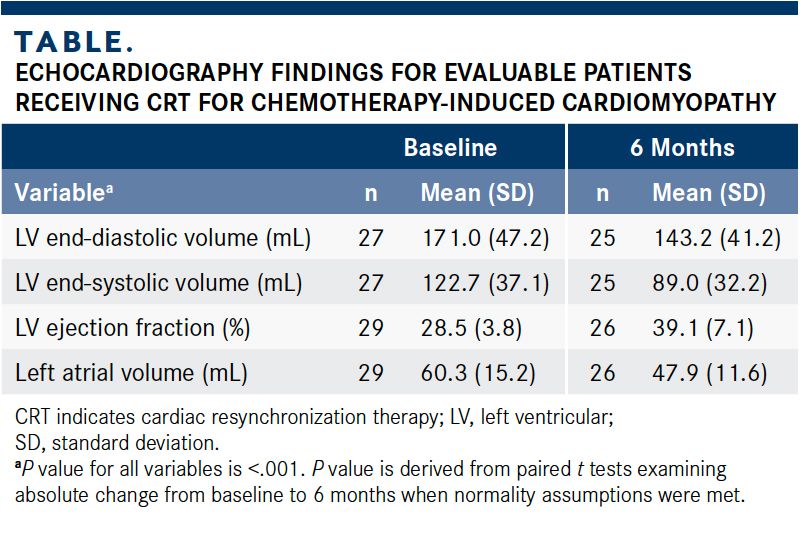Publication
Article
Oncology Live®
Cardiac Therapy Improves Heart Function in Patients With Chemotherapy-Induced Events
Author(s):
Cardiac resynchronization therapy improved heart function in patients who developed chemotherapy-induced cardiomyopathy.
Cardiac resynchronization therapy (CRT) improved heart function in patients who developed chemotherapy-induced cardiomyopathy (CHIC), according to findings from a small study published in JAMA. At a 6-month follow-up, 24 of 26 patients (83%) had either no symptoms or mild symptoms of heart failure after CRT.
CHIC is a progressive weakening of the heart muscle that can present in patients treated with chemotherapy, and has specifically been linked to anthracyclines. Patients with CHIC are known to develop heart failure months or even years after undergoing chemotherapy; however, most patients show signs of cardiac dysfunction within the first year of treatment. Progressive heart failure and mortality rates can be as high as 50% within 2 years of diagnosis, authors said.
The MADIT-CHIC trial (NCT02164721) evaluated CRT in 30 patients with CHIC. Its primary end point was change in left ventricular ejection fraction (LVEF) from baseline to 6 months after initiating CRT. Results showed that patients with CRT experienced a statistically significant improvement in mean LVEF at 6 months. Specifically, LVEF rose from 28% to 39% (difference, 10.6% [95% CI, 8.0%-13.3%]; P <.001).
CRT also led to a reduction in left ventricular (LV) end-systolic volume, which decreased from 122.7 mL to 89.0 mL (difference, 37.0 mL [95% CI, 28.2-45.8, P <.001]). LV end-diastolic volume dropped from 171.0 mL to 143.2 mL (difference, 31.9 mL [95% CI, 22.1-41.6, P <.001]; Table).
Table. Echocardiography Findings for Evaluable Patients Receiving CRT for Chemotherapy-Induced Cardiomyopathy (Click to Enlarge)
MADIT-CHIC investigators enrolled 30 patients with reduced LVEF (LVEF ≤35%) from 12 tertiary centers with cardio-oncology programs between November 21, 2014 and June 21, 2018. They implanted 26 patients with a commercially available CRT defibrillator and 4 patients with a CRT pacemaker.
In MADIT-CHIC, a CHIC diagnosis consisted of previous exposure to chemotherapy known to impair LV function, an absence of prior heart failure at chemotherapy initiation, and the development of heart failure marked by systolic dysfunction ≥6 months after treatment without an evident alternative cause.
Although tyrosine kinase inhibitors and immunotherapies have been associated with LV dysfunction, investigators said anthracyclines are the most common cause of cardiomyopathy. Anthracyclines are a cornerstone of treatment for lymphomas, soft tissue sarcomas, and breast cancers.
Notably, most MADIT-CHIC enrollees (83%, n = 24) were previously treated with anthracyclines at a mean equivalent cumulative doxorubicin dose of 307 mg/m2. All patients had symptomatic heart failure. A minority of patients received prior cyclophosphamide therapy (n = 3), trastuzumab (Herceptin; n = 1), dasatinib (n = 1), and docetaxel (n = 1).
Most patients had a history of breast cancer (73%, 22 patients); 20% had a history of lymphoma or leukemia (n = 6), and 7% (n = 2) had a diagnosis of sarcoma. The median age at cancer diagnosis was 52 years, and the median time of heart failure diagnosis was 13.8 years from the patient’s last cancer diagnosis.
CRT therapy uses electrical resynchronization to correct mechanical dyssynchrony, ease hemodynamic stress, and improve heart contractility, cardiac perfusion, and metabolism. These effects have been shown to improve functional capacity, quality of life, and long-term survival while reducing hospitalizations for heart failure, authors said. They added that CRT also has the potential to induce molecular changes that can reverse CHIC.
As the population of patients who have survived cancer continues to grow, the incidence of CHIC concurrently rises, authors said. MADIT-CHIC was “the first prospective, multicenter clinical study” to evaluate CRT in this patient population, according to investigators.
Singh JP, Solomon SD, Fradley MG, et al. Association of cardiac resynchronization therapy with change in left ventricular ejection fraction in patients with chemotherapy-induced cardiomyopathy. JAMA. 2019;322(18):1799-1805. doi: 10.1001/jama.2019.16658.
At the 6-month follow-up, CRT was associated with a reduction in left atrial volume from 60.3 mL to 47.9 mL (P <.001). Data indicated that CRT generally improved (41%) New York Heart Association Classification status: 19% of class II patients and 69% of class III patients had better functional status after CRT. There was 1 instance of heart failure requiring hospitalization; no deaths occurred during the trial.






























%20(2)%201-Recovered-Recovered-Recovered-Recovered-Recovered-Recovered-Recovered-Recovered-Recovered-Recovered-Recovered-Recovered-Recovered-Recovered-Recovered-Recovered-Recovered.jpg?fit=crop&auto=format)
%20(2)%201-Recovered-Recovered-Recovered-Recovered-Recovered-Recovered-Recovered-Recovered-Recovered-Recovered-Recovered-Recovered-Recovered-Recovered-Recovered-Recovered-Recovered.jpg?fit=crop&auto=format)
